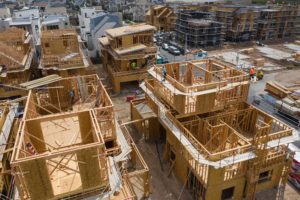The Missing Middle | Montana Housing Shortages at All Price Points
In Montana’s popular cities, we hear a lot about two extremes: expensive, out-of-reach homes (all the way up to million-dollar mansions) or affordable housing. What’s missing? It’s those homes (and families) in the middle. That’s where the missing middle comes into play in Montana.
But what’s the “middle?” Nationally, that number can vary a great deal. In general, a household making between $48,500 – $145,500 qualifies as middle class. Get more details on this income range from the Pew Research Center.
(However, in places like Missoula and Bozeman, it might take a great deal more to secure housing. You can find out more here).
Coined in 2010, “missing middle” housing isn’t necessarily a new concept. Duplexes, townhouses, stacked triplexes, and live/work complexes fall into the “missing middle” category. Think small footprint, mid-density construction. Usually more affordable, these housing types can suit single folks, roommates, couples, and families to create a diverse neighborhood.
What Does a Missing Middle Neighborhood Look Like?
Because missing middle housing looks and feels different from high density apartment complexes, it blends in with other housing types. Done well, these mid-density units can coexist with single family houses, mid-rise apartments, and higher density buildings. On missingmiddlehousing.com, the style is described as “compatible in scale and form to detached single-family homes.”
Since missing middle housing brings in more people, there is usually an emphasis on creating local amenities, shops, and safe and walkable spaces. That might mean having a neighborhood coffee shop, parks, a restaurant close by, and perhaps even a grocer down the block. As a result, there is a greater sense of community.
Advocates Say…
Lower costs are the main feature of missing middle housing. Others call this blended housing and mixed-use style “the antidote to sprawl.” In a place like Montana, with such an “acute supply shortage of homeownership options,” the missing middle is a crucial stepping stone for the middle class to attain home ownership and start building equity.
Additionally, increased rates of homeownership have demonstrated social benefits. In neighborhoods with high rates of home ownership, there is less crime, better community health, and positive educational outcomes.
Opponents Say…
Like most mid-to-high-density housing options, missing middle has its fair share of neighborhood pushback. “It will make my neighborhood no LONGER a neighborhood but unsightly areas of quickly/cheaply built dwellings (NOT homes),” wrote an angry opponent of legislation to facilitate missing middle housing in Oregon.
And, other opponents say that homeownership for the sake of ownership is a net negative for a community. Not only are the costs of owning substantial, owning a home can actually hinder growth if people are tied to a real estate investment and forego job opportunities and other investment goals to attain homeownership.
Upshot
All together, as our population grows rapidly, there is no question that Montana needs more housing options. For places like Missoula, those options can’t materialize fast enough. With the median home price rising and outpacing wage growth, building “missing middle” might bridge the gap between poorly perceived high density housing and more PR-friendly single family homes.
Get more info on Montana multifamily opportunities with Nick Chaussee.



